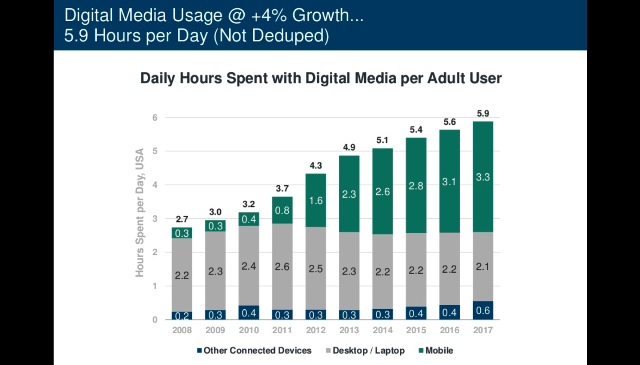 The 2018 Internet Trends Report from Mary Meeker, a partner at Kleiner, Perkins, Caufield & Byers, is one of the most anticipated studies on internet and technology trends. With 294 slides, it’s also the most comprehensive. In addition to internet use, the report covers everything from Apple products to YouTube views. It offers data relevant to most all businesses. These are key statistics and takeaways for marketing and PR.
The 2018 Internet Trends Report from Mary Meeker, a partner at Kleiner, Perkins, Caufield & Byers, is one of the most anticipated studies on internet and technology trends. With 294 slides, it’s also the most comprehensive. In addition to internet use, the report covers everything from Apple products to YouTube views. It offers data relevant to most all businesses. These are key statistics and takeaways for marketing and PR.
Moving to Mobile
Almost a third (29%) of time spent in media (print, radio, TV, desktop, and mobile) occurs on mobile devices. However, marketers allocate just 26 percent of advertising budgets to mobile. That three-percentage-point gap equals a $7 billion missed opportunity, according to Meeker.
Internet growth is peaking. Worldwide, 3.6 billion consumers can access the internet, representing 49 percent market penetration. Growth in the number of new internet users is already slowing, and new growth will become more difficult as market penetration surpasses 50 percent. Yet people spend more time connected to the internet with mobile devices. Time spent engaging with digital media while on mobile devices has reached 3.3 hours a day, more than twice as much in 2012. Improvements in new mobile devices, which offer improved simplicity, speed and ease of use, drive the trend.
The takeaway: Brands have an enormous opportunity reach consumers through mobile marketing and advertising.

Image source: Kleiner, Perkins, Caufield & Byers
Social Media Becomes an Ecommerce Factor
Social media is growing as a referral source and ecommerce channel. A third of U.S. consumers now use social media, and users spend 135 minutes on social networks every day. Social media referrals to e-commerce sites have grown from 2 percent in 2015 to 6 percent today. A surprising 55 percent of consumers ages 18 to 65 have bought a product online after social media discovery.
“Social media is enabling more efficient product discovery in commerce,” Meeker said while presenting the report at Recode’s Code Conference last week, CMO reports. “A material portion of people that have used social media have found products on social media, and a material portion have purchased those products after finding them on social media.”
The takeaway: Savvy marketers will be able to drive sales, in addition to increasing brand awareness, with social media.
Ecommerce Accelerates
Ecommerce increased 16 percent in the U.S. in 2017, up from 14 percent in 2016. Amazon took a 28 percent of those sales last year. Meanwhile, physical retail sales are declining. Almost half of product searches start at Amazon, while 36 percent start on a search engine.
The internet has enabled online retailers to reduce costs and drive sales through online marketing, says Taylor Schreiner, principal analyst at ADI.
“If you are a largely offline company, whoever’s selling to your consumers online is going to be fighting you really hard on prices,” Schreiner told CMO. “The retailers that sell both online and offline are going to have a particularly challenging time because they have really divergent pressures.”
The takeaway: Online marketing and sales are becoming imperative for most brands. Offline retailers will need a highlight their distinctive value propositions to survive.
A Focus on Video
The average person watched almost 30 minutes of mobile video per day last year, up from about five minutes per day in 2012. YouTube sees 1 billion daily views of learning videos, and 70 percent of viewers use the platform to help solve work, school, or hobby problems.
The takeaway: Marketers can promote their brands and products through video, especially with instructional content that involves their products. “Marketers, make sure your videos look right on Android and iOS phones,” writes Sean Callahan in the LinkedIn Marketing Solutions Blog.
Bottom Line: The 2018 Internet Trends Report offers a treasure trove of information on internet and general technology trends. Marketers can examine its statistics and insights to help guide their long-term strategies.
William J. Comcowich founded and served as CEO of CyberAlert LLC, the predecessor of Glean.info. He is currently serving as Interim CEO and member of the Board of Directors. Glean.info provides customized media monitoring, media measurement and analytics solutions across all types of traditional and social media.




